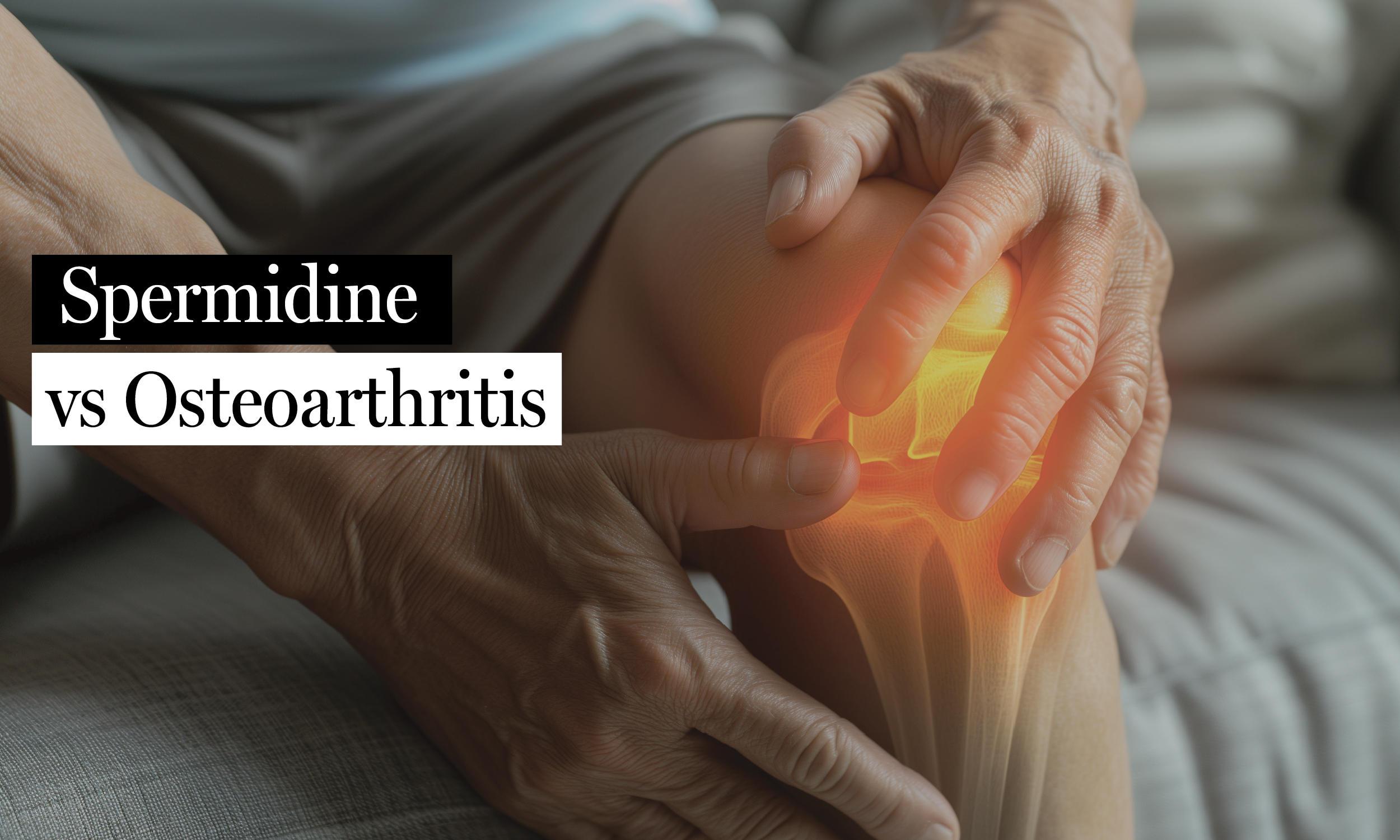
Osteoarthritis is a debilitating condition affecting millions worldwide, characterized by joint pain, cartilage degradation, and inflammation. Traditional treatments often focus on relieving symptoms rather than addressing the underlying causes of joint degeneration. Excitingly, emerging research points to spermidine as a potential game-changer in osteoarthritis management. In this blog, we dive into how spermidine supports joint health, protects cartilage, and may slow the progression of osteoarthritis, drawing on insights from recent scientific studies.
What is Osteoarthritis?
Osteoarthritis (OA) is a common condition that affects the joints, where two bones meet. It happens when the protective cartilage that cushions the ends of your bones wears down over time. Without this cushioning, the bones can rub against each other, causing pain, stiffness, and swelling. Think of cartilage as a shock absorber for your joints: when it’s damaged, movement becomes harder and more uncomfortable.
What happens in osteoarthritis?
- Cartilage breakdown: The smooth, slippery cartilage that helps your joints move easily starts to wear away.
- Bone changes: Without enough cartilage, the bones in the joint may thicken or develop small bony growths called spurs.
- Inflammation: The tissue around the joint can become irritated, leading to swelling and pain.
- Loss of movement: Over time, the joint may become stiff and harder to move.
What does osteoarthritis feel like?
People with osteoarthritis often experience:
- Pain: Joints may hurt during or after movement.
- Stiffness: Especially in the morning or after sitting still for a while.
- Swelling: The area around the joint may look puffy.
- Cracking or popping sounds: You might hear or feel a grating sensation when moving the joint.
- Difficulty moving: Over time, the joint may not move as easily as it used to.
Who is at risk for osteoarthritis and what can be done about it?
Osteoarthritis, often called “wear-and-tear arthritis,” becomes more common with age, but it’s not just about getting older. Past joint injuries, excess weight, repetitive movements, and a family history of OA can all increase the risk. While there’s no cure, the condition can be managed through gentle exercise, weight management, medications, physical therapy, and, in severe cases, joint replacement surgery. Excitingly, new research into natural compounds like spermidine suggests it may help protect cartilage, reduce inflammation, and slow OA progression, offering hope for improved joint health in the future.
How Spermidine Supports Joint Health in Osteoarthritis
1. Spermidine restores autophagy in osteoarthritic chondrocytes
Autophagy, the process of cellular self-cleaning, declines with age and contributes to OA progression. This decline is evident in aged human and mouse cartilage, which shows reduced expression of autophagy-related genes (e.g., ULK1, Beclin1, LC3) and proteins, along with decreased autophagosome formation as seen in a study published in Experimental & Molecular Medicine. The reduction is even more pronounced in osteoarthritic cartilage compared to healthy aged cartilage. Spermidine levels and the expression of key enzymes responsible for polyamine synthesis are also reduced in aged and osteoarthritic chondrocytes (the cartilage-building cells), correlating with decreased autophagy.
However, spermidine supplementation can restore autophagy in aged and OA chondrocytes by increasing autophagy-related gene and protein expression, enhancing autophagosome formation, and boosting markers of chondrogenesis such as type II collagen (the main structural protein in cartilage) and SOX9 (a transcription factor that regulates chondrocyte development). Mechanistically, spermidine activates autophagy via the acetyltransferase EP300, which enhances the activity of proteins like Beclin1 and LC3, promoting cellular health and reducing cartilage degradation. These findings highlight that, while aging and OA impair autophagy and spermidine synthesis, supplementation can reverse these deficits and support cartilage repair (Sacitharan et al., 2018).
2. Spermidine reduces inflammation and pyroptosis
Inflammation and pyroptosis (a form of programmed cell death) are key drivers of OA progression. In a study published in Frontiers in Immunology, spermidine demonstrated anti-inflammatory and anti-cell-death effects by targeting the AhR/NF-κB pathway (a cell signaling system that controls inflammation) and the NLRP3/caspase-1/GSDMD pathway (a pathway that triggers a form of inflammatory cell death called pyroptosis). Its anti-inflammatory effects were AhR-dependent, as silencing AhR negated its protective effects. In a rat model of OA, spermidine reduced levels of inflammatory markers such as IL-6, TNF-α, and PGE2, preserved cartilage integrity, and suppressed extracellular matrix degradation by reducing cartilage-degrading enzymes MMP-3, MMP-13, and ADAMTS-5. It also increased the synthesis of type II collagen, the main structural protein, and aggrecan, a proteoglycan that provides cushioning and shock absorption in cartilage. Histological and imaging evidence confirmed that spermidine mitigates cartilage destruction and limits osteophyte formation (small bony growths around joints), highlighting its ability to reduce inflammation and support overall joint health (Guo et al., 2024).
3. Spermidine modulates macrophage polarization
Macrophages are a type of immune cell that helps detect and respond to tissue damage or infection. They play a critical role in OA by influencing inflammation and cartilage degradation. In a study published in Biochimica et Biophysica Acta, spermidine shifts macrophage polarization from the pro-inflammatory M1 phenotype to the anti-inflammatory M2 phenotype (supports tissue repair). This transition reduces the release of inflammatory mediators such as IL-6 and IL-1β while increasing anti-inflammatory cytokines like IL-10 (Yuan et al., 2021; Ou et al., 2024). This altered inflammatory environment prevents excessive production of matrix-degrading enzymes (MMP3 and MMP13) and supports the synthesis of cartilage components like type II collagen, further protecting cartilage from degradation (Ou et al., 2024).

Spermidine restores type II collagen in cartilage
This figure shows the expression of type II collagen (detected by immunohistochemistry, in brown), a key protein for maintaining cartilage structure, in the articular cartilage of mice. In the DMM group (destabilization of the medial meniscus, a surgical mouse model that induces osteoarthritis), type II collagen levels are markedly reduced compared to the control (Sham), indicating cartilage degradation. However, in the spermidine (SPD)-treated group, type II collagen levels are noticeably higher, suggesting that spermidine helps protect and promote cartilage repair by restoring type II collagen synthesis. Scale bars represent 200 μm. Adapted from (Ou et al., 2024).
Spermidine: Easing the Wear-and-Tear on Joints
Spermidine is a natural compound with multifaceted benefits for osteoarthritis. By restoring autophagy, reducing inflammation, modulating macrophages, and preserving cartilage, it targets multiple pathways involved in osteoarthritis progression. While further clinical research is needed, current evidence suggests that spermidine may offer a natural way to protect joints, support mobility, and bring hope to those living with osteoarthritis.







